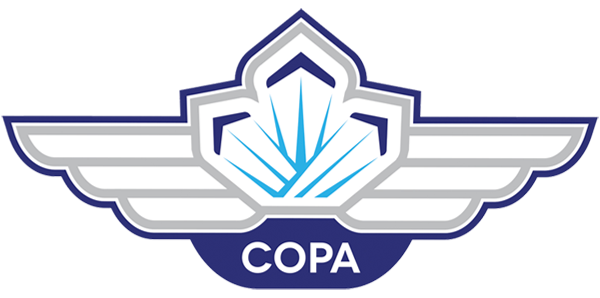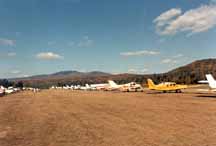COPA History: the 1950s and 1960s
This collection of information was researched, gathered, and collated by Garth Wallace.
“Something needs to be done”
The idea to form COPA was born in April, 1952. Back then, Laurentian Air Services pilot John Bogie was having lunch in the Ottawa Flying Club lounge with Spartan Air Services pilot Bill Peppler and Paul Saunders when Ottawa pilot Margaret Carson came storming in and declared that something had to be done about the way small aircraft owners and operators were being mistreated by the government. At the time no one was looking after the small operators and individual aircraft owners in Canada.
One of the issues that sparked Carson’s initiative was the application of highway tax on aviation gasoline. As a result of that informal discussion, interested local Ottawa pilots chipped in $5.00 each to pay for printing and mailing of notices. An organization meeting was held on Friday, Dec. 12, 1952, at 1:30 p.m. in the Ottawa Flying Club lounge.
Bogie acted as chairman of the meeting and Carson acted as secretary. It was moved by Margaret Carson, seconded by Angus Morrison, that the committee contact J. B. Hartranft, Jr., of Washington, president of AOPA to ask if he could arrange to come to Ottawa during January to meet with the committee to discuss organization of an association such as AOPA in Canada and exchange of AOPA services.
The AOPA of Canada
AOPA’s “Doc” Hartranft accepted the group’s invitation to come to Ottawa. A meeting was scheduled for January 30, 1953. Word spread of the proposed new organization for light plane pilots and operators. Forty-eight people filled a meeting room at the Chateau Laurier Hotel in Ottawa.
John Bogie was appointed acting chairman, Dorothy Drew of the RCFCA was the recording secretary. Hartranft addressed the group outlining how AOPA was run. He pledged financial support. A Canadian Advisory Council (CAC) was proposed to initiate the group’s activities until a formal organization to be called “AOPA of Canada” could be chartered.
When COPA was formed in 1952: There were less than 7,000 pilots in Canada: Private – 4,560; Commercial – 1,240; Transport – 775. There were 966 privately registered aircraft in Canada and 1,294 commercially registered.
The First Meeting
The first meeting of the CAC was held in Kingston, Ont. on Feb. 13, 1953. It was then decided to write to the Department of Transport objecting to it making nautical miles mandatory in Canadian aviation (The manufacturers in the United States were using statute miles).
The Departments of Highways in each province was to be sent a letter objecting to road taxes on aviation gasoline. The DoT was to be asked to make ground controlled approaches available to civilian aircraft and to install radios in military radar stations for communicating with civilian aircraft.
At a meeting in Ottawa on March 4, 1953 the group set the membership fees for AOPA of Canada at $5.00 per year. A Canadian newsletter was sent to be included in an AOPA (U.S.) mailing (This newsletter was produced in Margaret Carson’s basement).
By May, 1953, members of the proposed AOPA Canada were being offered:
- Assistance with personal flying problems;
- Legal aid in Canada;
- Employment assistance;
- Flight routing service;
- Map distribution;
- AOPA Canada newsletter;
- Group aircraft insurance;
- A subscription to Canadian Aviation magazine for an extra $2.
The Canadian Owners and Pilots Association is born
At a June 1953 meeting it was decided to rename the proposed organization the “Canadian Owners and Pilots Association” to avoid confusion with AOPA in the United States.
Canadian Flight magazine
In 1955, COPA launched Canadian Flight, “The pilot’s magazine.” The first edition carried a “June 1955” label on it. The 52-page magazine was compiled by Margaret Carson, who by now had moved the COPA “office” from her basement to her garage. The initial issue sported a colour cover and black and white inside, covering early ELTs (called “SARAHs”), civil defence, converting to a helicopter licence, tips on buying a used aircraft, a business aircraft buyer's guide, building a single-strip airport, weather, gliding, places to fly and much more.
COPA grows
In 1956, Robert (Bob) Thomas, a retired RCAF Wing Commander, agreed to assume the duties of manager of COPA. That same year, clerical staff was hired including Joyce Else and Norma Girard. One of their first tasks was to move COPA’s operations from Margaret Carson’s garage to an office on Wellington St. in downtown Ottawa. The year 1957 saw COPA growing and shifting from a mostly volunteer organization to one with paid staff and a proper office in Ottawa. In January 1957, temporary Manager Robert Thomas resigned. The board sought a permanent manager for the association. William “Bill” Peppler started work on July 2, 1957, beginning a 39-year run as manager of the association.
Search and rescue with COPA
That same year COPA organized a civil air search group in Ottawa called “Emergency Air Corps.” This was patterned after the Civil Air Patrol in the United States and similar groups in Canada. Meetings were held with Royal Canadian Air Force personnel to coordinate plans and efforts for civil aircraft and pilots to join in searches for missing aircraft.
COPA also launched group aviation insurance for its members engaging Donald C. Miller Ltd. of Montreal to administer liability and hull coverages.
At the time, COPA membership fee was $10 per year. Corporate Memberships were launched at $25 per year.
Providing administrative services for the Canadian Business Aircraft Operators (today’s CBAA)
In 1958, COPA agreed to act as an umbrella organization for the newly formed Canadian Business Aircraft Operators, the forerunner of the current Canadian Business Aircraft Association. COPA provided administrative services for the new organization from its new office on 77 Metcalfe St. in Ottawa.
The COPA Annual Meeting in St. Jovite in 1959 included a celebration of the 50th year of powered flight in Canada.
Staff changes
In 1960, Margaret Carson ended her time as COPA’s secretary/treasurer and as publisher of the Canadian Flight magazine but continued volunteering and promoting the association for several more years. John Bogie took her place on COPA’s executive committee. COPA manager Bill Peppler became the magazine editor assisted by Art MacDonald.
Annual general meetings
In 1961, COPA’s Annual Meeting moved to Muskoka Sands Inn in Gravenhurst, Ont. north of Toronto as the St. Jovite site was becoming too small for the growing number of members flying to the event.
In 1962, COPA’s AGM was held in September. The 300 attendees heard banquet guest speaker Ed King, president of King Radio, talk about the upcoming requirement for communication radios to operate on a 100-KHz split.
Aviation by the numbers in the 1960’s
At the beginning of 1962, there were 5,885 civil aircraft registered in Canada of which 3,708 were privately registered. There were 14,597 pilot licences in force. A government list of airports showed there were 265 licenced and 444 unlicenced land airports in Canada; 276 licenced and 287 unlicenced water airports; and 82 military airports. The newest airport added to the list was at King City, 15 miles northeast of the Malton Airport near Toronto, Ont.
Key pilot issues in the 1960’s
Also that year, part of a survey of COPA members indicated that pilot medicals conducted by designated examiners were costing anywhere from $5.00 to $10.00. The government doubled the cost of Canadian Aeronautical charts from 25 cents to 50 cents. COPA opposed the move and advised its members that there were American charts that covered southern Canada that cost 25 cents. The Canadian dollar in 1962 was worth $1.09 U.S.
Elsewhere, COPA was working with the Department of Transport to have the maximum weight of a homebuilt aircraft increased from 1,200 to 1,750 lbs. The association also appealed to the government not to be too hasty in its conversion of radio ranges to non-directional beacons as few of Canada’s aircraft were equipped with automatic direction finders.
New board positions
In August of 1963, at COPA’s Annual Meeting in Kingston, Ont., eastern and western vice-president positions were initiated. Charles “Chuck” Leavens was elected COPA’s first eastern vice-president and Neil Armstrong was elected as the first western vice-president.
In 1964, the cost of a COPA membership was raised to $12 a year. By the end of the year, COPA’s membership topped 6,000.
In 1967, as COPA celebrated 15 years of service to aviation, the country celebrated its 100th birthday.
Herb Cunningham joined the COPA Board of Directors beginning his first of 34 years of service to the association. Mid-year in 1967, Frank Kennerly of Toronto succeeded Neil Armstrong as president of the COPA Board, a position he held until 1971. Ernie Antle of Vancouver became the 1st vice-president and Barry Graham of Montreal was appointed 2nd vice-president. John Bogie remained as secretary/treasurer.
Advocacy wins
The minute books of COPA director meetings grew thicker in the late 1960s as manager Bill Peppler represented the association to various government departments on behalf of general aviation.
COPA approached the Department of Transport and asked for a method of operating newly-imported aircraft under a temporary Certificate of Registration rather than waiting until it was processed and mailed.
It was also a COPA initiative that led to flight training becoming an acceptable educational tax deductible expense for income tax purposes.
COPA also worked with the Flying Farmers to launch the idea of using reflectors for night flying on private airstrips.
COPA Flights
The COPA Flights program started in 1964. By 1967, the Sudbury, Ont. COPA Flight became number 13, joining others in Guelph, Ont., Regina, Sask., Ottawa, Ont., Sarnia, Ont., Saskatoon, Sask. and Victoria, B.C. Today, there are well over 100 COPA Flights across the country.
Aviation growth
In 1967 there were 28,887 Canadian pilot licences in force, up from 25,742 the year before. There were 18,484 private pilots and 926 glider pilots. Also in 1967, there were 8,454 aircraft registered in Canada, an increase of 780 over the year. Of these, 8,057 aircraft were under 12,500-lb gross weight.
COPA’s highest honour at the time (1979), the AOPA Silver Tray was presented to John Bogie – COPA’s founding president, a long-time director, secretary/treasurer, convention chairman and vice-president (in that order) for his contributions to the association.



